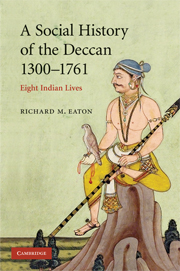Book contents
- Frontmatter
- Introduction
- 1 Pratapa Rudra (R. 1289–1323): the demise of the regional kingdom
- 2 Muhammad Gisu Daraz (1321–1422): Muslim piety and state authority
- 3 Mahmud Gawan (1411–1481): Deccanis and Westerners
- 4 Rama Raya (1484–1565): élite mobility in a Persianized world
- 5 Malik Ambar (1548–1626): the rise and fall of military slavery
- 6 Tukaram (1608–1649): non-brahmin religious movements
- 7 Papadu (fl. 1695–1710): social banditry in Mughal Telangana
- 8 Tarabai (1675–1761): the rise of Brahmins in politics
- Select bibliography
- Index
- Plate Section"
- References
6 - Tukaram (1608–1649): non-brahmin religious movements
Published online by Cambridge University Press: 28 March 2008
- Frontmatter
- Introduction
- 1 Pratapa Rudra (R. 1289–1323): the demise of the regional kingdom
- 2 Muhammad Gisu Daraz (1321–1422): Muslim piety and state authority
- 3 Mahmud Gawan (1411–1481): Deccanis and Westerners
- 4 Rama Raya (1484–1565): élite mobility in a Persianized world
- 5 Malik Ambar (1548–1626): the rise and fall of military slavery
- 6 Tukaram (1608–1649): non-brahmin religious movements
- 7 Papadu (fl. 1695–1710): social banditry in Mughal Telangana
- 8 Tarabai (1675–1761): the rise of Brahmins in politics
- Select bibliography
- Index
- Plate Section"
- References
Summary
The brahmin who flies into a rage
at the touch of a mahar [a low caste]
– That’s no brahmin.
The only absolution for such a brahmin
Is to die for his own sin.
He who refuses to touch a chandal [a low caste]
Has a polluted mind.
Says Tuka, a man is only as chaste
As his own belief.
TukaramTO THE BANKS OF THE INDRAYANI RIVER
The year 1608 saw Malik Ambar confidently moving about the western Deccan, his armies building on success after success. Just two years earlier, he had defeated his rival for leadership of the anti-Mughal resistance movement, Raju Dakhni, who now languished in a prison in the fort of Junnar, the temporary capital of the revived Nizam Shahi state. In 1608 Malik Ambar also negotiated an alliance with his neighbor to the south, Sultan Ibrahim II of Bijapur, so that he could concentrate all his forces on thwarting the gathering Mughal threat from the north. His efforts paid off, for just two years later, the Mughal garrison in Ahmadnagar would fall and the Habshi peshwa would be emboldened to move the Nizam Shahi court from Junnar further north, to Daulatabad.
While these events were taking place at the level of high politics, one of India's most revered poets was born in the village of Dehu, on the banks of the Indrayani River some forty miles south of Malik Ambar's capital at Junnar. This was Tukaram, whose life spanned the period 1608 to 1649 (see Plate 10). Familiar to millions of ordinary Marathi-speakers, Tukaram's verses, or abhangs, would enter the collective consciousness of a substantial portion of the Deccan's population. While historians have approached his career from many perspectives, we are most interested in the impact his life and work had on the social history of the seventeenth-century Deccan.
Keywords
- Type
- Chapter
- Information
- A Social History of the Deccan, 1300–1761Eight Indian Lives, pp. 129 - 154Publisher: Cambridge University PressPrint publication year: 2005



